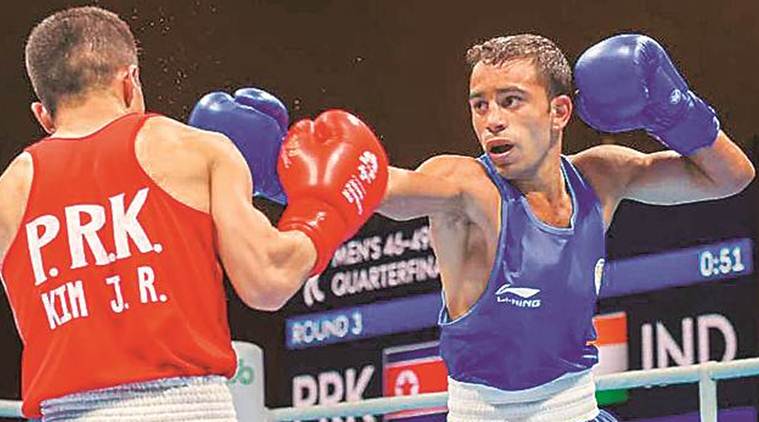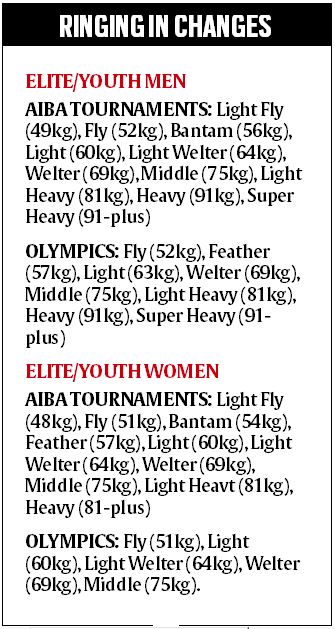
After months of speculation, AIBA has finally revealed the new weight-categories for the 2020 Tokyo Olympics. Men’s category will now have eight divisions, down from 10, while women have five divisions, up from three. This essentially means that boxers around the world will have to recalibrate their game plan, like facing taller opponents and putting on more weight, all in a bid to be more competitive in a higher division. For example, Amit Panghal will have to move up from 49 kg to 52 kg while Shiva Thapa, a 60kg division boxer, will now have to upgrade to 63kg.
Panghal, the current poster boy of Indian boxing, enjoyed considerable success in the past 15 months in the light-fly division, with his biggest scalp coming in the final of the Asian Games in the form of Rio Olympics gold medalist and 2017 World Championship silver winner Hasanboy Dusmatov.
While light-fly remains a category in AIBA’s Elite and World Competitions, this is one of two weight-categories to be axed from the Tokyo Games. Santiago Nieva, Indian boxing’s High performance Director, admits shifting to a higher weight class is not ideal for Panghal. “For us, it is a hard blow as one of our strongest boxers (Amit) will have to shift to 52kg. We have seen what he has done in the 48 kg category. He has a small physique, and with this change, he will have to compete against much taller boxers,” Nieva told The Indian Express. In the 52 kg category, boxers tend to rely more on height and reach and a boxer like Amit will have to counter that with speed.
Nieva believes that with most countries having a larger pool of boxers in the lighter weight categories will make it more competitive for boxers with Olympic aspirations. Apart from the light-fly category, the new Olympic weight categories in the men’s division sees the reintroduction of feather-weight (57kg) and welter-weight (63 Kg) – replacing three weight categories of bantam (56kg), light (60 kg) and light-welter (64 kg).
Beijing Olympic quarter-finalist and 2006 CWG champion Akhil Kumar has competed in weight categories ranging from light-fly to light-weight and says that it’s important for Indian boxers to have the right mindset.
“It’s not a new thing for world boxing. Weight division changes have happened in the past and AIBA takes such decisions after consultation and meeting with the officials and boxers. In Sydney Olympics, there were 12 weight categories before it was reduced to 11 in 2004 and 2008 Olympics. In the London Olympics, the weight categories were reduced to ten. When I competed in Beijing, I competed in bantam category before it was made 56kg. In World Championships in Milan, I competed in 57kg and then changed to 60kg. The issue will be how coaches train the boxers for a particular weight category,” Kumar, who started his senior career in light fly (49kg) category, said.
A move to bring gender parity
While the Rio Olympics saw 286 boxers - 250 men in 10 weight divisions and 36 women in three weight divisions - the International Olympic Committee's emphasis on gender equality has resulted in reduction in the number of pugilists competing in men’s events. Now, 206 men will fight in eight weight categories and 80 women in five weight divisions.
The new changes also mean that there will be an addition of two new weight divisions for women in the form of feather (57kg) and welter (64kg), with fly-weight (51kg), light-welter (60 kg) and middle weight (75kg) being other categories. Six-time world champion Mary Kom had won her last world title in the light fly (48kg) category.
“Mary Kom has worked hard in the fly-weight category. Boxers like Kim Hyang Mi of Korea, who won the bronze in light fly (48kg) and current world champion in bantam weight (54kg) Lin Yu-ting of Chinese Taipei are taller. If Mi adds more body weight, it can be advantage along with her height in fly-weight (51kg), where height makes a difference. The new two weight categories will add to India’s chances for Olympic medal as we have many boxers, who have won medals in world championships in these categories. The key will be to try as many boxers in these weight divisions,” Shiv Singh, former chief coach of Indian women’s team, said.

Other changes
Apart from the weight categories, AIBA has also revised the world ranking and seeding criteria apart from the introduction of the bout review, which comes into effect from September 2019.
The specifications for the bout review equipment will be notified later. According to the new rules, a bout review must be lodged by the boxer’s second within one minute after the decision is announced and the bout review jury, comprising an observer, referee evaluator and judge evaluator, will determine the winner based on three scoring criteria after the review is accepted.
“We have been skeptical about the bout review rule. Boxing is still a very subjective sport and not that everybody feels the same about scoring decisions in a bout, which lasts for three rounds. As a opponent, you always feel that you have won the bout. The review system will count on three scoring parameters, which is based on the number of blows on target areas, domination of a bout by technical and tactical superiority and competitiveness which is again subjective. It’s not like hockey, where the video referral is taken for seeing a goal or a defender foul which is clearly visible and can be overruled,” Nieva explained.
HC restrains IABF from using ‘India’ or ‘Indian’ in its name
PTI adds: The Delhi High Court passed an interim order on Thursday restraining Indian Amateur Boxing Federation (IABF) from using ‘India’ or ‘Indian’ in its name. Justice Prathiba M Singh also asked IABF, which was in the process of conducting a national sub-junior men and women boxing championship, to inform all the participants that they are not a recognised national sports federation of boxing.
The court’s interim order came on a plea by Boxing Federation of India (BFI) seeking permanent injunction against IABF from using word ‘India’ or its natural variations and from representing themselves as a national sports federation for boxing or that it is recognised by Indian Olympics Association, sports ministry and AIBA. Advocates Hrishikesh Baruah, Parth Goswami and Hemant Phalpher, representing the BFI, submitted in the court that IABF was in the process of conducting national sub-junior men and women boxing championship in Jabalpur and was collecting money from boxers as entry fees.